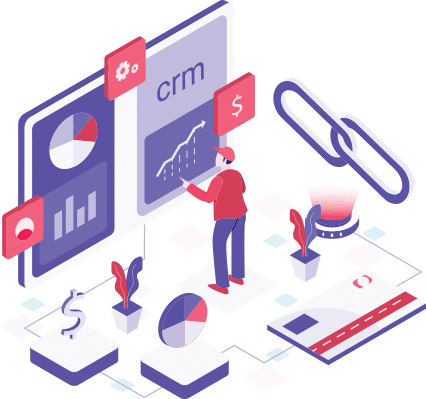
Get Better Results with Buyer Intent Data
Volume Two: Using and Applying Intent Data
The promise of intent data can seem as if you will suddenly have qualified leads galore! A sales team dialing for dollars! Quotes on quotes on quotes! New customers! But reality is somewhat different: Leads are raw intelligence and need to be analyzed and processed so they can be activated. See how to make intent data work for you with these use cases and application tips.
Beyond Leads
Most folks who are new to intent data visualize a land of milk and honey. Qualified leads galore will occupy a sales team dialing for dollars and securing orders just waiting to be written. Reality is somewhat different.
These leads are a form of raw intelligence. They need to be analyzed and processed. Activation is key, particularly for companies that see them simply as sales leads. There are several common use cases for contact-level third-party intent data.
Demand Generation
This is the default application for most rapid-growth companies. And the most common buyers of thirdparty intent data are demand gen teams. Demand gen folks integrate it into their programs in various ways. The simplest and most common is to provide likely leads and prioritization guidance to the BDRs & SDRs to help them focus on the most active/promising leads for outbound prospecting and inbound follow-up.
Another interesting demand gen application is enhancing conversational marketing. By incorporating contextual information from granular third-party contact-level intent data, chatbots can be personalized for website visitors attracted to the site by outbound BDR prospecting. Particularly when combined with firmographic insight, this will create a natural and compelling prospect experience to accelerate the sales process. Custom audiences for nurturing and conversion ads can also be very effective. By targeting those specific users (email match rates are often higher than expected >50 percent) who have demonstrated intent, targeted ads are more effective than when shown to a broad audience.
Event Marketing
Event marketing is all the rage these days. You’re not a legit, rapid growth tech firm if you don’t have your own event or sponsor others while aspiring to have your own. Huge portions of marketing budgets are directed at events, and filling seats is the imperative. Third-party intent data can be used by both organizers and sponsors.
Organizers can use the data by observing direct event signals (hashtag, website, social, speaker profiles, etc.) they can match against unknown, past and registered attendees. They can use that information to focus direct outreach and nurture conversion ads to custom audiences according to the details of the profile.
Organizers can also use broader signals to identify folks that would probably want to attend if they knew of the event. What are the problems that the event will help attendees solve? What are the hashtags, influencers and key topics that will be involved? Those leads are a great custom audience for a different type of awareness ad nurturing and perhaps special offers on registration.
Sponsors can use intent signals to identify leads likely to attend and target them in advance with offers and messaging. Sponsors can also target leads who are interacting with competing sponsors. In both cases, the data will provide leads for outbound prospecting as well as paid ad nurturing.

Account-Based Marketing (ABM)
Recognizing current activity and inertia from accounts on long target lists helps to prioritize efforts. Identifying key players involved in a complex buying discussion broadens the audience for nurturing ads with tools like Triblio and Terminus. Receiving context on the specific actions of each player helps strategic sales teams understand where each player is in their thinking and buying journey—even the problem they’re trying to solve. Observing competitive interactions provides critical sales intelligence.
The Achilles heel of most ABM is the disconnect between account-based intent and the individuals that are engaged in the discussions and planning. Ask most ABM tools to provide that intent, and the answer is often some version of, “That’s technically impossible,” or “We’d love to, but that’s illegal.” That’s frustrating for companies that work hard to identify ideal target accounts but know that in order to succeed, they have to create personalized marketing and create compelling, authentic, sales interactions.
Certainly, there’s some value in knowing that “person A” in a target company has taken action (even if you don’t know who they are) and using that as a justification to show ads, or initiate direct outreach to the people who hold titles that are most likely to be involved in a buying decision. But was it them? Are they even aware of someone’s research several layers below? Are they a good fit?
Great practitioners of ABM speak of the difficulty of managing the process at scale. It’s all dependent on personalization, and third-party intent data, which doesn’t provide contact details and identify other players likely involved in the process, is simply providing a whiff of the smoke and inferring that there’s fire. In contrast, contact-level third-party intent data fuels the ABM process with granular, actionable intelligence, as well as insight into the thoughts and buying roles of the 6.8 buyers that CEB predicts are involved.
Pro Tip: Contact-level third-party intent data that provides granular contextual information creates amazing opportunities for elusive marketing and sales alignment. The tools that marketing normally owns now provide real-time, actionable insights to help salespeople win and save deals. Struggling with silo competition and inefficiency? Intent Data might provide exciting results.
Strategic Sales
How many deals in your pipeline are stagnant? Why are they? How many of your deals end in no decision? How often does a different player emerge at the last minute to disrupt a “done deal?”
These are common scenarios, aggravated as buying teams grow and consensus decisionmaking becomes more popular.
Salespeople selling complex deals always need more information about what’s happening with key players. Who is working in the background? What are various players thinking? Who’s onboard and who is looking for alternatives? While third-party intent data can’t replace highly skilled, creative salespeople, contact-level data and granularity of insights can prove to be a treasure trove for skilled and insightful salespeople
Success, Loyalty & Churn Reduction
Success, Loyalty & Churn Reduction
These scenarios—reducing churn and increasing cross/upsell among existing customers—are huge priorities for many rapid-growth companies. But the data, the intelligence upon which preemptive actions can be taken, is often missing. Too often churn awareness arises when the non-renewal notification arrives, and the upsell is a scramble to discount to avoid letting the camel’s nose under the tent.
Competitive Monitoring
Google News and press releases are the common currency of product marketers working to understand and parse the competitive landscape. They are helpful but barely begin to capture the texture of complex business environments. Detailed intent data provides a rich source of aggregate information and lots of opportunity for deep-dive analysis (e.g. around specific topics, events, industries, competitors, etc.). This is critical insight that can enrich the competitive marketing capability for companies in industries where multiple vendors and good products create a sense of parity for many buyers.
The End Result: Marketing and Sales Alignment
It’s a fond dream among CEOs and CROs, and one rarely realized. Imagine a team of growth and product marketers working collaboratively with inside, field and channel sales, and even supporting the customer success team. The functions, goals and KPIs for the teams are fundamentally different. That’s why it’s such a vexing problem—one that has defied a great solution for thousands of companies and many years.
Will great contact-level third-party intent data fix that on its own? Absolutely not. A toxic culture will take more than collaboration to repair. But in most companies, teams of good people want to work collaboratively—they just need the glue to enable it. In those cases, the detailed insights available through intent data can simultaneously invigorate marketing demand gen AND provide the tools and insights they need to explicitly support their sales and success colleagues.
The natural collaboration fosters alignment. And that could provide as powerful a boost to your growth as the data itself.What to expect when you buy
A Solid Foundation
Do you understand your buyers? Do you know what a good prospect looks like? Do you have a clear sales methodology (that’s different than a process)? Do you have well-developed battle cards and strong competitive information? Do you even have a process for identifying target accounts? Do you know the business issues your buyer is trying to solve? What business resources do you have to work the leads? How will marketing and sales collaborate? What ad budget do you have for PPC nurturing ads? These are questions that you’ll have to answer as you launch the process, and it’s best to chew on them in advance.
If you select a data solution that’s simply a database or one that requires you to select three or six or 10 “topics,” then you can delay this work until you’re receiving leads. They’ll have to be answered eventually, though, so why not now? You may find that the process of thinking through these questions, the resulting introspection and the conclusions you draw will reveal a landscape that suggests a different version of intent data (perhaps even a reboot of the growth function).
You’re really better off doing this first.
Building a Custom Algorithm
This is going to take some work. The alternative is to select a data source that only asks you to pick a couple of topics and take whatever leads you get. That’s easier up front for sure, but you can probably guess at the back-end implications.
Plan on providing lists (names and URLs) of customers, competitors, influencers, events, target accounts and key terms that would indicate intent at different stages in the buying journey. You’ll also pull together important hashtags, details on your ideal buyer (job titles, functions, seniority) and firmographics (size, industry, location). This free template is available to help with the process. All these factors are baked into the algorithm. That takes a bit of time, and it takes a bit of patience.
Databases let you sift through verified names immediately. Third-party intent data based on topics just spits out the topic data. But a custom algorithm takes time to learn and to mature. Similarly, your interaction with the data will lead to lessons learned. In some cases, you’ll gain insight to tweak the algorithm to yield better optimized results over the first month or two. In other cases, you’ll have even more radical revelations—some companies even realize they’ve been incorrectly positioning their product or trying to sell to the wrong target group.
Integration - Yes or No?
Many intent data services tout native integrations with common CRM and marketing automation platforms. There’s no doubt that immediately reflecting intent signals in alerts to salespeople can be incredibly valuable, particularly within target accounts and ABM playbooks, as well as pending opportunities. It’s at the core of “operationalizing” your data.
But should all intent data be flushed into the CRM, particularly when it’s not opted-in and can’t be included in marketing email campaigns until there’s interest established? Some of it will be noise, particularly if you’re collecting “leads” that have been shown an ad exchange ad. Some may have potential, but aren’t a great fit.

Some might provide great competitive insight when viewed as trends and in aggregate but not as individual records in the CRM. Indiscriminately adding records to a marketing automation system often involves a carrying cost. That cost depends on the platform, but there’s often an incremental cost per thousand contacts. Third-party intent data could easily add >2,000/week. Consider a system that will let you create multiple, segmented delivery options. Perhaps one campaign that filters target accounts and pending deals is immediately fed into the CRM, while a list of bottom-ofthe-funnel signals is reviewed in a CSV by the BDRs every day, and a list of all data is reviewed as a CSV by the marketing team weekly. You may even find that sorting, filtering and pivot table options are critical to understanding large scale-trends and spotting opportunities.
You’ll decide what’s right for you, but as a guideline, any data requiring ACTION should be imported. The Account-Based Marketing Intent Data Onboarding Workflow provides a helpful visualization. Any data benefiting from ANALYSIS may be better off delivered in a format to facilitate that.
Activation
How will the leads be nurtured? What’s your process for outbound prospecting (methodology, steps, cadence, etc.)? What’s a good call-connect rate depending on the stage in buying journey? Who will create the copy and graphics for the Facebook nurturing and conversion ads? Who will integrate the intent data with your chat playbooks? How many contacts should you be touching per account in order to increase success rates?
These are the kinds of questions you’ll face as the data starts to come in. For companies accustomed to second-party intent data leads, this will be a bit of a transition. For companies familiar with static lists, this creates an entirely different usage approach. And for companies that have grown accustomed to accountlevel intent data, there’s a whole additional set of steps that are required to unlock the value embedded in granular context and specific contact details.
The Privacy question
If you’re using or considering intent data, certainly privacy is a pressing question today.
There are three elements to consider.- How your data is sourced and what exposure you might have
- How you use the data
- The “Creepy Factor”
Data Source
Is the data you’re using collected in any way that violates Terms of Use of other sites or tools? By using it are you creating potential exposure for your company?
Lattice Engines CEO Shashi Upadhyay lays out the considerations in his article “Why your Intent data is becoming illegal and what to do about it” Highlights include:
“If you care about GDPR compliance, make sure your Intent provider is not using AddThis as their primary data-source….From a compliance perspective, Intent providers relying on bidstream stand on very weak ground...While providers based on bidstream and AddThis can promise higher volume of Intent data, they can’t deliver on compliance with consent requirements.”
It’s likely that the data you’re using or considering is probably OK. Opaque and convoluted Terms of Use may make it difficult to ascertain, especially if they’re several levels removed for data acquired through publisher networks and website applets.
And you can always use the New York Times cover story test:- Have you satisfied yourself that the source of your data isn’t on the edge of what’s appropriate?
- Would you be completely comfortable justifying your research, confidence and use of it?
At the very least, make questions around the data source part of your product/vendor comparison process. If you’re comfortable with the candor of the answer, that may be a good proxy for the appropriateness of the data.
Data Use
Third-party intent data provides you a golden opportunity to be an even more responsible marketer by focusing your message in a way that will be genuinely helpful to people who are currently active. That being said, they haven’t opted-in to your mass email list, nor consented to certain other uses of their data. It’s up to you and your team to use the data responsibly to create a better experience for prospects and customers and drive mutually beneficial results for your company.
Don’t Be a Creep
The granularity of context and individual contact details make high-quality third-party intent data incredibly powerful. It means that you can actually put helpful information in front of the right people when they need it. Using a Challenger Sales™ approach (or other outcome-based methods), great marketers and salespeople will do exactly that.
Remember, these prospects don’t know what you know, and clumsy sales execution like saying, “Wait, you said you were buying from me, so why are you still taking action on my competitor’s content?” will sour prospects quickly and obviate the value of the data. Use the information carefully to help, not harass. Use empathy.

Pro Tip: IntentData.io data is publically available and GDPR- and ICO-compliant. However, it’s up to you to use it responsibly and within the guidelines your organization has for compliance with applicable marketing and data privacy laws
Subscription Considerations
Some intent data is sold by the lead (e.g. very specific second-party intent data). Most is sold on a subscription basis, and providers generally seek to lock customers into the longest feasible subscription. That may earn you a discount, but what’s in your interest as the buyer? What’s a reasonable subscription duration?
How Fast Does Your World Change?
The answer to that probably depends on some other questions. How frequently do your prospects’ online behaviors change? How confident are you in the quality of the data you’re considering? Have you compared it side-by-side in a controlled test against other options? What might AI bring to the intent data space in the near future? What new signals might be collected and reported that would be helpful but aren’t currently available from any provider? Which collection methodology supports the fastest adaptation? Do you generate the same number of PPC and inbound leads per week or month? Why does that vary?
The digital world is extremely fluid. Just in the intent space, early 2019 has seen both new Series A funding for a Scandinavian company with interesting potential, and consolidation as Aberdeen acquired Mintigo.
As you look to strike the optimal balance between economy of time and money (subscription discounts for longer duration and avoiding researching too frequently versus flexibility to respond when circumstances change you should plan for long enough to prove the concept, but short enough to preserve your options.How Long Does it Take to Know if it Works?
Generally, it takes a minimum of three months to have a full sense of how effective intent data will be for your organization or to compare data solutions side-by-side. A really robust algorithm that’s custom built for your company, ideal buyer and buying journey details will take some time to tweak and mature. Some sites offer the opportunity to select a topic and get an immediate sampling of the representative leads you’d expect from a pre-built topic cluster, and the incongruity of some of those initial samples may give you immediate cause for concern. During that initial three months, you’ll have a chance to experiment with different activation options (custom audiences for social ads, BDR outreach, etc.) and by the end you’ll certainly have a good sense of likely value, and the resources required to fully unlock that value.
And then you need some time to actually execute at scale. Plan on three months for a reliable indication and six months for fully developed operational insights and measurable, meaningful results.
Why a One-Year Subscription?
Intent Data is a bit different than the SaaS products many mid-market tech companies are accustomed to buying. There’s no good freemium version (at least with custom-built algorithms), and it takes time to let leads work through your process.
Find a vendor that’s realistic about how long you’ll need to get proficient, but confident enough in their data (or free of opportunistic investor backing that demands long-term lockups) to provide quarterly subscriptions with cancellation prior to any renewal, for any reason.

Pro Tip: IntentData.io data is publically available and GDPR- and ICO-compliant. However, it’s up to you to use it responsibly and within the guidelines your organization has for compliance with applicable marketing and data privacy laws
Conclusion

Intent data, in its many varieties and versions, offers enormous potential value to rapid-growth companies. But it’s an evolving space where traditional list vendors circulate with both legitimate AI groundbreakers and investor-backed opportunistic businesses.
If you’re responsible for demand gen performance or carry a P&L, we hope that this guide has provided some clarity and insight into your options and how you might select the one best suited for your requirements. It might not come as a big surprise that we believe contact-level, granular and contextual third-party intent data is often the best answer.
It draws from activity around the entire internet, yet delivers the critical information that’s necessary for both sales and marketing to unlock the value. However you decide to proceed, take stock of your full range of options and make the right decision for your business and objectives not simply based on the most seductive claims.
Let's Talk. Schedule a Meeting with Ed Now.
